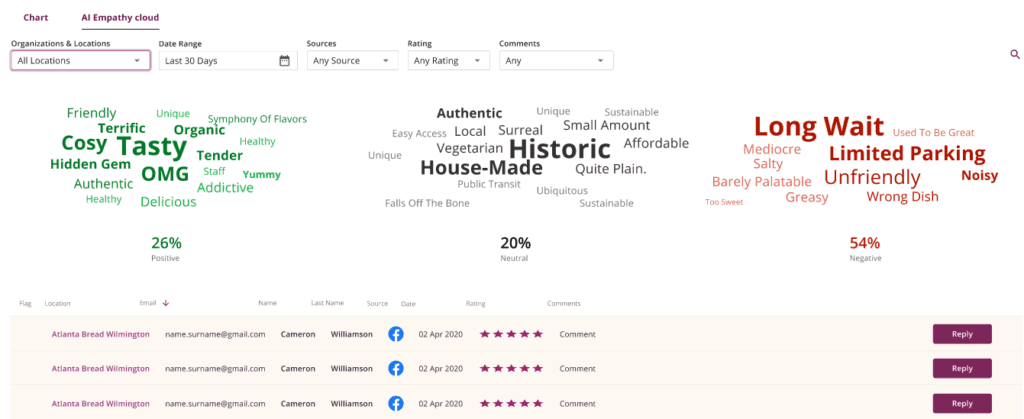In today’s restaurant industry, where a single online review can sway potential diners, managing your establishment’s reputation has never been more crucial.
With a majority of patrons reading reviews on websites like Google, Yelp, TripAdvisor, or Facebook before dining out, the power of digital word-of-mouth is undeniable.
In fact, according to Zippia, 92% of diners read restaurant reviews before attending a restaurant. A 2023 survey by BrightLocal found that 98% of consumers occasionally read online reviews when researching local businesses, and 76% read them regularly or always.
That’s why it is critical to have a rock-solid restaurant reputation management strategy that includes consistently obtaining ratings and reviews. Equally vital is ensuring a response to each of these reviews.
To attract new guests, and to keep your current guests coming back, it is important to manage and maintain positive ratings and reviews on a consistent basis.
Here are 10 tips for restaurant reputation management that will help you get consistent positive ratings to help your business grow.
1. Consistently Monitor Ratings and Reviews
The first step in using ratings and reviews to improve your business is to monitor and evaluate them closely and consistently.
Getting on a regular schedule of evaluating and responding to your reviews can help. As you immerse yourself in this consistent review evaluation, you’ll likely start noticing certain trends or recurring themes.
These patterns could be indicative of both strengths and areas for improvement within your business. When you identify an issue, good or bad, you should take immediate action to improve it.
It’s imperative to not only address these issues swiftly but also to ensure you maintain a steady and ongoing practice of monitoring and engaging with your guest reviews. This ongoing engagement is key to understanding customer sentiment and improving your business offerings continuously.

2. Respond to All Ratings and Reviews
A study by TNS NIPO researched over 2,000 negative online customer ratings and concluded that overall 70% of complainants hope to receive a response, while just 38% receive one. According to TNS NIPO, the success of the response is determined by 3 factors:
- The speed of the customer review response time.
- The quality of the solution provided to the customer.
- How the response is provided, and how genuine the response is perceived.
Likewise, responding to positive reviews can greatly improve the reputation of your restaurant.
Other upsides to responding to negative and positive reviews include making a huge difference in customer loyalty, customer service recovery, and new customer acquisition.
3. Showcase Your Ratings On Your Website
 As your ratings and reviews continue to build, it is a good idea to showcase those ratings on your website and social media platforms. This is powerful social proof.
As your ratings and reviews continue to build, it is a good idea to showcase those ratings on your website and social media platforms. This is powerful social proof.
Wherever possible, showcase your aggregate ratings to your followers and website visitors.
You can also use Bloom’s configurable ratings widget to proudly display all your new positive ratings on your website.
When potential guests come to your website to see your menu or learn more about you, these positive ratings act as social proof to further encourage them to come to your locations.
Over time you will likely see your ratings and reviews become even more positive. This leads to more new patrons and retention of your current customer base, which equals increased customer lifetime values and revenue for your business.
4. Make Negative Ratings Good
Even if you strive to provide stellar customer service, a guest will eventually have a negative experience.
As author and customer service strategist John Tschohl explains, “If there’s an industry that seems to have more problems, and more difficulties, and more things that can happen that are bad, it’s got to be in the restaurant business.”
Customer service recovery refers to the process of identifying a negative customer experience or a dissatisfied customer, responding to them and resolving their issue, and then converting them into a more loyal customer than if they had never had the negative experience.
This creates an excellent opportunity for you to convey to the guest how valuable they are to you and your business.
Here is a great post about how to respond to negative reviews.

5. Create Ratings Feedback Loops
Using a restaurant customer data platform like Bloom Intelligence, it is simple and easy to create an automated feedback loop to help improve your online ratings and reviews.
When a guest leaves your restaurant, an initial message will be sent to thank the guest and ask them to rate their experience.
If the guest leaves a negative review, a secondary message can be sent that would offer an apology for providing anything less than stellar service and can include an incentive to get them back through your door for that valuable second chance.
The idea is to grab the guest’s attention and offer some kind of resolution to their issue before they get to an online ratings website.
If they know their issue is being addressed in a friendly and positive manner, they will most likely refrain from complaining online.
The best part is that the entire process is automated and runs behind the scenes while you concentrate on running your business.
6. Use AI to Know Customer Sentiment
Not only are positive ratings and reviews good for your bottom line, but they are also great for spotting trends and measuring customer sentiment.
Measuring customer sentiment can give you very deep insight into your customer base. It tells you not only what customers like and dislike, but the reasoning behind the way they feel that way.
The first step in utilizing reviews to measure sentiment is to monitor and evaluate them consistently. Once you are on a regular schedule of evaluating your reviews, you may begin to see patterns emerging.
When an issue is identified, good or bad, always take swift action to improve it.
For instance, if you are seeing consistent positive comments about a certain product, you might want to feature it as a special.
Or, if you see consistent negative reviews about a certain item, you could try modifying it, or removing it from your menu altogether.
Bloom Intelligence makes this even easier by providing an artificial intelligence-generated word cloud showing positive, neutral, and negative customer sentiment. It’s an easy way to quickly spot trends and improve upon them.

7. Use AI to Optimize Marketing and Operations
8. Incentivize Your Wait Staff
Your wait staff plays a pivotal role as the primary interface between your restaurant and its clientele, effectively serving as the face of your establishment to the outside world. They engage in more direct communication with your guests than any other part of your team.
Considering this, it can be highly beneficial to motivate them to actively encourage ratings and reviews from guests who are evidently enjoying their experience.
Imagine a scenario where a waiter notices a guest visibly delighted with their meal, perhaps they’ve finished every bite on their plate, or they’ve expressed their satisfaction through generous tipping.
In such instances, your staff can be encouraged to politely encourage these guests to share their positive experiences by leaving a review online. This not only helps in boosting your restaurant’s online presence but also reinforces positive customer experiences.
To further incentivize your staff in this endeavor, you could introduce tangible rewards. For instance, offering a complimentary meal for two or a monetary bonus for every certain number of positive reviews garnered can be a great way to motivate your team.
This approach not only benefits your restaurant through an enhanced online reputation but also fosters a sense of achievement and satisfaction among your employees, creating a win-win situation.

9. Discuss In Employee and Management Meetings
To ensure that restaurant reputation management remains a priority for every member of your team, it’s essential to integrate it as a key discussion point in all staff and management meetings.
During these meetings, take the time to talk about the nature and volume of the ratings and reviews your restaurant is receiving. Analyze both their quality and quantity, highlighting what guests appreciate and areas where there’s room for improvement.
This kind of analysis provides valuable insights that can guide your team’s actions and strategies.
Encourage an open forum for brainstorming where employees can contribute innovative ideas on how to enhance the guest experience and, in turn, garner more positive reviews.
This collaborative approach not only fosters a sense of team spirit but also taps into the diverse perspectives and creativity of your staff.
Make it a point to acknowledge and commend team members who receive direct mentions in customer reviews. Highlighting these positive shout-outs in meetings can be a great morale booster and motivate other employees to strive for similar recognition.
By regularly discussing these aspects, you emphasize the importance of maintaining and improving the restaurant’s reputation, both online and offline.
This ongoing conversation keeps reputation management at the forefront of your team’s mind, encouraging them to actively contribute to positive guest experiences and, consequently, to the overall success of the restaurant.
10. Discover Bloom Intelligence
It’s time to start leveraging the power of advanced restaurant reputation management tools to grow your business.
Bloom can save you a great deal of time and energy by automating guest rating requests, displaying all your ratings and reviews in one place, and showing you accurate customer sentiment which you can use to improve customer experience.
This is only one small part of what Bloom can do to save you more time, increase customer lifetime values, increase the number of positive online reviews, win back lost guests, and improve your restaurant reputation.
If you’d like to see the Bloom restaurant marketing platform in action, and discover how you can grow your business through guest intelligence and marketing automation, schedule a free demo or call 727-877-8181.





.svg)